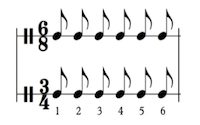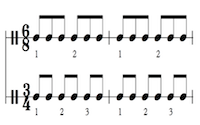At first glance, measures with either a 6/8 or 3/4 time signature could be filled with six eighth notes (see figure below), so how are the two different in terms of music theory, and do we need to approach them any differently in our playing?

First, let's make sure we're clear on what a time signature is!
The Music Theory of Time Signatures
For any time signature, the upper number denotes how many beats are in a measure/bar, and the bottom number indicates what type of note value gets the beat.
For instance, 6/8 means that we'll count six beats in a measure and the type of note that we're counting as a beat is the eighth note. However, each measure doesn't have to only have six eighth notes. Whatever note values (or rests) it has simply need to all add up to the value of six eighth notes. A bar of 6/8 could be filled with two dotted quarter notes (each equal to three eighth note beats), a quarter note (equal to two eighth notes) plus four separate eighth notes, or even a dotted half note (equal to six eighth note beats). We could imagine countless more examples, but the point is that each time the measure will add up to six eighth note beats.
6 = number of beats in a measure
8 = what type of note value counts as a beat
Although these time signatures look like fractions, we should never think of them as such. Each time signature gives the beats and types of notes we're counting as the beat for each full measure, so thinking about time signatures as fractions might confuse us into thinking that some measures are more complete then others. They are all complete bars, we'll just approach playing the music they contain a bit differently.
In contrast, thinking about the note values within our measures in terms of fractions can be very helpful in some settings, yet there are also instances where we can confuse ourselves thinking this way. Quarter notes are called such because four of them fit into a bar of 4/4, in other words, each take up a quarter of the measure. Yet only three of them could ever fit into a bar of 3/4. They are called quarter notes and look like quarter notes regardless, even though in this example each of them now would take up a third of a 3/4 measure.
However, if we were baking a cake and found that we only had half the cup of flour we needed for the recipe, we could use only half the amount of all the other ingredients and make a smaller, yet equally tasty cake. Similarly, when we're trying to figure out how all our note values relate to one another, regardless of the time signature, a half note could divide into two quarter notes, a quarter note could divide into two eighth notes, etc. or two quarter notes could add up to one half note, or two half notes could add up to one whole note. In this way, thinking in terms of fractions can be very helpful.
Since we only have a handful of note values to choose from, the number on the bottom of a time signature will often be a 4, 8, or 2, and less commonly a 16, or a 1. We'd never see, for instance, a 7 or a 3 as the bottom number. Note values that those numbers could represent simply don't exist.
The note values these lower numbers signify are as follows: 4 = quarter note 8 = eighth note 2 = half note 16 = sixteenth note 1 = whole note
Meanwhile, a time signature's upper number could technically be any number, though typical choices in Western music are 1 through 12 beats in a bar, with 4, 3, 2, and 6 being the most common, followed by 9 and 12, and on much rarer occasion, 1, 8, 5, and 7.
The most common time signatures include: 4/4 (also called "common time" and sometimes indicated with a "C" at the start of a piece), 2/4, 2/2 (also called "half common time" and sometimes indicated with a "C" plus a vertical line drawn through it), 3/4, 6/8, 9/8.
From here we can categorize our time signatures into duple vs triple vs quadruple meter, simple vs compound meter, and also as irregular meters.
Duple vs Triple vs Quadruple Meter
First, let's define meter. Closely related and sometimes used interchangeably with time signature, meter refers to the overall stress pattern and flow of the beat structure and rhythms, rather then the very specific information the time signature gives us. It's more about what we feel and hear versus what we see on the page. More on all of this in a bit.
If the time signature contains two beats per measure we call it duple meter, three and we call it triple meter, and four and we call it quadruple meter.
Examples of duple meter are: 2/4, 2/2, 6/8, 6/4
Examples of triple meter are: 3/8, 3/4, 3/2, 9/8, 9/4
Examples of quadruple meter are: 4/4, 4/2, 4/8, 12/8, 12/4
Notice that while it would be very convenient if duple meter always had a "2" on top, triple always had a "3" and so on, duple meter can also have a "6" on top, triple can also have a "9" on top, and quadruple can also have a"12" on top. This is because measures with meters having a 6, 9, or 12 as the top number are often populated with shorter note values (eighth notes, 16th notes, etc.), and especially when the tempo is faster, even though this goes against what the key signature tells us, standard practice is to count the dotted quarter note (or dotted half note in the case of meters with a 4 on the bottom) as the beat instead of the eighth note (or instead of the quarter note for meters with a 4 on the bottom).
In this case, 6/8 would be counted as two beats of three eighth notes (or any other note values that add up to three eighth notes), and thus we need to place it in the duple category. Just another example of music being full of guidelines and principles, but very few unshakable rules!
This is also where it's helpful to also understand our other way to categorize meters: simple vs compound.
Simple vs Compound Meter
A time signature with beats that naturally divide into two is called simple meter, while a time signature with beats that naturally divide into three is called compound meter.
Examples of simple meter include: 2/4, 2/2, 3/8, 3/4, 3/2, 4/4, 4/2
Examples of compound meter include: 6/8, 6/4, 9/8, 9/4, 12/8, 12/4
Adding the two ways to categorize together, we get time signatures that can be defined as: Duple Simple Meter: 2/4, 2/2 Duple Compound Meter: 6/8, 6/4 Triple Simple Meter: 3/8, 3/4, 3/2 Triple Compound Meter: 9/8, 9/4 Quadruple Simple Meter: 4/4, 4/2 Quadruple Compound Meter: 12/8, 12/4
Here we do have an easy pattern we can follow: simple meters always have a 2, 3, or 4 as the top number, while compound meters always have a 6, 9, or 12. Again, we see that compound meter assumes we're counting dotted quarter or dotted half notes as beats rather than the eighth or quarter notes the time signature tells us we should be counting (the meter vs time signature conundrum). Yes, it's a bit confusing, but with experience we quickly realize how counting 1-2-3-4 for 12/8 and subdividing each beat into whatever rhythms our note values indicate is MUCH less cumbersome then counting 1-2-3-4-5-6-7-8-9-10-11-12 and often still needing to add or subdivide from there! The phrasing will also flow much more freely applying these broader beats rather getting hung up on the tiny chunks of time.
Another common example of how we might choose to count a longer chunk of time as the beat rather then what the time signature tells us is when we're playing quickly in 3/4. Anyone who's ever played in an orchestra will have seen or made the dreaded marking: "In 1." Gulp. As the conductor ticks their baton easily up and down, the musicians play frantically, fitting the notes of each measure into just one wave. Although this practice places the burden of subdividing onto the musician, the goal is a more cohesive, flowing sound (not to mention less strain on our conductor or our metronome!).
Irregular Meters
Irregular meters must be divided into beat groups that are a mix of two and three. For example, common irregular time signatures (which aren't common as a category in general) include: 5/4, 5/8, 7/8, 7/4.
Strong vs Weak Beats
While metronomes might lead us to believe that each beat is created equal, each time signature will have its own unique feeling (meter) - a mix of stronger and weaker beats determined by how the measure's beats and note values naturally add up or divide. This is where we really start to notice the similarities and differences between various time signatures, including our 6/8 vs 3/4.
For instance, 4/4 and 2/2 both could have measures filled with four quarter notes, and typically those quarter notes should have a strong-weak-less strong-weak emphasis. However, the third quarter note of a measure in 4/4 should typically feel a little weaker then the third quarter note in a 2/2 measure. In fact, 2/2 should probably be played closer to 2/4 then to 4/4, even though without knowing the time signature, a measure of 4/4 looks exactly like 2/2, whereas we'd never mistake a 2/4 measure for 4/4!
And still, 2/2 and 2/4 are also not quite identical. While 2/2 is played strong-weak-less strong-weak, 2/4 would be just strong-weak, or if we expand to two measures in 2/4 we'd have strong-weak-strong-weak.
Is any of this really enough for the audience to notice? Maybe not in this example of closely related time signatures, but certainly in the case of signatures that are more distantly related. Also, we're thankfully likely to see note values within these different types of time signatures that help us create the right feeling.
And Our Verdict on 6/8 vs 3/4?
No, they aren't the same. Based on what we've just learned, just as sheet music with these time signatures will be notated differently, we can't play 6/8 exactly the same way we play 3/4, at least not if we want to create stylistically accurate phrasing.
As we've discovered, while 3/4 is simple triple meter (three sets of two), 6/8 is compound duple meter (two sets of three). Put more practically, this means that while bars of each could be filled up with six eighth notes, the eighth notes in 3/4 should sound like strong-weak-less strong-weak-less strong-weak (a waltz), while 6/8 should sound like strong-weak-weak-less strong-weak-weak (a jig).

As mentioned, we're also likely to see note values that help us create this feeling. At least in instrumental music, our 6/8 measures are likely to be populated with a lot of figures that look like triplets (three eighth notes beamed together), as well as dotted quarter notes, one quarter note paired with a single eighth note, a dotted eighth note beamed with a 16th note and a regular eighth note, and sextuplets (six 16th notes beamed together).
In contrast, in 3/4 time we're likely to see quarter notes, half notes, eighth notes beamed in pairs, 16th notes beamed in sets of four, a dotted eighth note paired with a 16th note, and actual triplets (three eighth note looking notes beamed together, indicated with a 3, and played within the space of just one beat).
However...
Obviously we could go on to talk about the nuance of every time signature, but at least 80% of our time playing music will be filled with the handful of meters mentioned at the beginning of this discussion.
The beats in 4/4, 2/4 and 2/2 typically flow in an alternating strong-weak pattern, while 3/4, 6/8, and 9/8 have a triplet like strong-weak-weak feel. Ah ha!! But didn't I just say that 3/4 was strong-weak-less strong-weak-less strong-weak? And now I'm saying it's strong-weak-weak!! I would understand if your brain is exploding!
Let me clarify: 3/4 follows a strong-weak-less strong-weak-less strong-weak pattern for a measure that happens to be filled with straight eighth notes, but remember, in this time signature we're usually counting quarter notes as the beat, so it would be common to also see just three quarter notes filling a 3/4 measure, each one getting a beat to itself. When this is the case, the first quarter note is the strongest and beats 2 and 3 should be played weaker/less pronounced - strong-weak-weak.
Thankfully, these two stress patterns are still following the same principle though. Since we have to subdivide the strong-weak-weak beats to play the eighth notes (counting 1 and 2 and 3 and to keep track of our subdivisions rather then just 1 2 3), for simplicity, let's just put an 8 to help us keep track of where those eighth note "ands" fall within the standard 3/4 pattern: strong-8-weak-8-weak-8. In this updated example, each 8 should also symbolize a note that is played even weaker then the "weak" beats in the strong-weak-weak pattern. Therefore, we see how we can use this new example (strong-8-weak-8-weak-8) and the previous strong-weak-less strong-weak-less strong-weak interchangeably.
HOWEVER, if we were playing a very fast 3/4, and therefore probably also encountering more quarter notes and longer note values then eighth notes and shorter note values, yes, the music overall might start to feel pretty similar to 6/8!
Still, two measures of a fast 3/4 will be strong-weak-weak-strong-weak-weak while a measure of 6/8 will be strong-weak-weak-less strong-weak-weak. In other words, each down beat (first beat) in 3/4 is equally strong, while the fourth beat of 6/8 should always be a little less strong then the first.
To give us more context, here is how a drummer might approach playing in 6/8 versus 3/4:
Obviously there are more ways then one to play these grooves, but we hear how it takes twice as long for the drummer playing in 6/8 to cycle back to similar cymbal hits etc. then when playing in 3/4. This is because of the cycle of stressed and unstressed beats we've been discussing.
I also mentioned the dance forms of the waltz (3/4) versus the jig (6/8) earlier. Let's check out how dance steps contrast between these two time signatures:
Besides the formal feeling of the waltz and the more casual feeling of the jig, we notice how waltz steps tend to cycle every three beats, therefore contributing to a lot of spinning, whereas the jig cycles every 6 beats, therefore creating more of a figure 8 pattern of steps which move laterally from side to side. It would be very hard to mistake one of these dance forms for the other!!
Closing thoughts and practical considerations
As a step in our process of learning new music, it's never wrong to mentally think about one time signature in terms of another - like thinking about 2/2 as if it was 4/4 in order to more easily figure out the rhythms with less need to subdivide.
This type of practice can also help us with fitting rhythms into it a steady pulse in general and using a metronome. For instance, I've mentioned how we often count 6/8 as two dotted quarter note or two triplet feeling rhythms within a measure, but especially if the music is slow, we're finding it difficult to subdivide these longer chunks of time, or each broader beat contains many different note values, we might feel quite relieved to count our bars in 6 instead of 2, each eighth note, as the time signature tells us, actually getting the beat. If it gets really hard to accurately subdivide shorter note values we could even set a faster metronome beat intended to count 16 sixteenth notes in a 6/8 measure! The possibilities to aid practice in these ways are endless. However, once we get the gist of the rhythm we should practice the phrasing and beat structure as the composer intended.
Finally, we need to also remember that measures are usually not independent entities; I have yet to meet a piece that only had one bar! We must always consider the overall phrasing of the music when considering our approach. The micro and macro divisions of time are equally important if we want our music to be rhythmically accurate, yet also have feel. To take stock of how I'm doing with this, I always find value in recording myself and listening back. If I feel a 4/4 piece more strongly in 2 then in 4 (as is often the case for faster Classical music, Irish Reels, etc.), all the phrasing still makes sense, it has movement and emotion, I don't question it or force myself to play a way that only intellectually makes sense based off the time signature.
I hope this helps answer some questions, and I imagine it might also give you more to think about! Readers are certainly always welcome to reach out with questions! So often we glance quickly at the time signature (if we remember to at all!), but how often do we really consider everything it's trying to communicate to us? Once we consider the overall feeling and flow of the music, it's obviously more then just how many beats are in a measure and what kind of note value gets the beat!
Happy Practicing!
For more music theory I recommend https://www.musictheory.net/lessons

